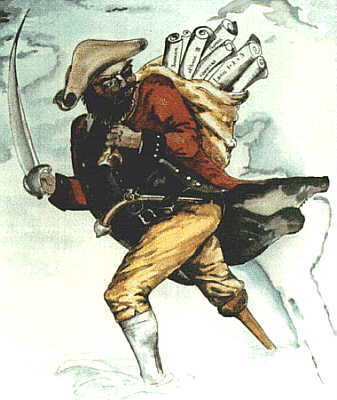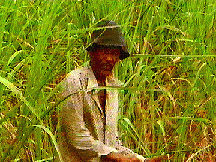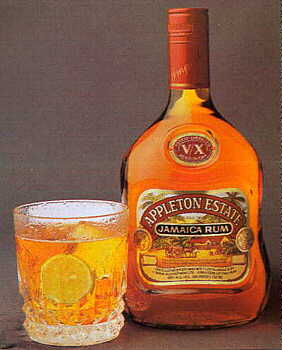Jamaican sugar cane
|
History
It has been suggested that sugar cane was first cultivated over 2000
years ago. In the Caribbean, it was introduced by Christopher Columbus around the late
fifteenth century.
Many people, when thinking about the early days of Jamaica conjure up
images of galleons, pirates like Captain Henry Morgan or the
incredible impact of slavery, indentured labour and the sugar industry. |
  |
The Mona Campus of the UWI in Jamaica, occupies lands that were part of two large sugar
estates: Mona and Papine. Of over 1000 acres at Mona, less than 200 were usually planted
in cane. (2.471 acre = 1 hectare). During the nineteenth century, the normal yield of
sugar would be around 1 hogshead per acre of cane (1 hogshead was on average 16 cwt) hence
200 hogsheads would be expected.
It has been calculated that to be economically viable a plantation needed to produce at
least 200 hogshead of sugar and a few estates in Jamaica managed 600 in a good year.
At Mona however, the average seems to have been more like 80 hogsheads and this low annual
yield suggests that the soils had deficiencies and the remnants of the aqueduct further
suggests that droughts were a problem.
Lady Nugent, in her journal, describes her visit to the Hope Estate on the 1st Oct
1801. She indicated that the Hope Estate produced 320 hogshead of sugar annually and that
because of the Hope River running through the property it was not as susceptible to
drought as some of the other plantations.
Part of the Hope Estate was acquired by the Government in 1871 to establish the Hope
Botanic Gardens which still exists. In addition there are now a number of Government
offices and laboratories located there, including the Government Chemist, the Scientific
Research Council, the Jamaica Bauxite Institute and the University of Technology.
Rum was an alternative income for the estates to sugar. By 1910, the Mona Estate had
only 30 acres in cane and from this came 35 hogsheads of sugar and 30 puncheons (about 200
gallons to the puncheon) of rum. This was insufficient to keep such a large property
solvent and soon after the property was sold to the Kingston General Commisioners. This
completed their control of the water-rights to the Hope River, previously held by the
three separate estates.
The Sugar Industry is the oldest continually operating industry in Jamaica, generating
the third largest foreign exchange earnings (after tourism and bauxite--not counting
illegal exports!!).
Sugar is the largest employer of labour, directly employing more than 50,000 workers.
Additionally, the industry with its renewable agricultural raw material base, has vast
potential for energy generation and establishment of small, high value fermentation and
sucrochemical industries.
The processing of sugar cane is one of the vital industries of the country to the
extent that small pieces of cane are often found in household refrigerators for chewing. A
1791 pamphlet published in an attempt to get the people of Great Britain to abstain from
West Indian sugar and rum so as to abolish the slave trade quotes the following attibuted
as Cowper's Negro's Complaint.
Why did all-creating Nature
Make the plant for which we toil?
Sighs must fan it, Tears must water,
Sweat of ours must dress the soil.
Think ye Masters, iron-hearted,
Lolling at your jovial Boards,
Think how may Backs have smarted
For the Sweets your Cane affords!
|
 |
The 1994/95 crop season saw 2,325,592 tonnes of cane harvested from
39,580 hectares (87% of the area in cane, which is about 4% of the total land area of
Jamaica). From this 212,476 tonnes of sugar was produced, down from 239,483 tonnes of
sugar in 1991/92.
The involvement of the Chemistry Department at Mona with the industry began many years
ago when the Department organised summer training courses for sugar industry laboratory
technicians. Since then, the relationship has grown with the establishment of the Factory
Technology Division of the Sugar Industry Research Institute (SIRI) whose laboratories
were initially housed in the old Applied Chemistry building on the Mona campus. (From
which the first lecture in the University was given in 1948). The Institute utilised both
human and physical resources of the Department in its formative years. Courses in Sugar
Cane Processing have been offered at various times at the Postgraduate level and a course
is currently being offered at the undergraduate level.
Since 1991, the Department has worked very closely with SIRI on a number of research
projects funded by the Institute. The broad areas of interest are:
- studies on dextrans in stale cane
- studies on sugar industry wastes for by-product development and pollution control.
- assessment of new methods of sugar processing and analysis for introduction into
factories
- formulation of new and improved methods for analysis of sugar cane products.
The history of Rum
The origin of the name rum is obscured, but rum has been known since the English
settled in Barbados in 1627 and it has been suggested that the Spanish and Portugese were
possibly involved in distilling spirits on their sugar plantations even earlier than this.
One possible derivation is from the Latin for sugar saccharum another has been
given as..
the name Kill-Devill alias rumbullion was given to the
first beverages in Barbados which were notably rough and unpalatable and could
"overpower the senses with a single whiff" and were "a hot hellish and
terrible liquor".
With time and experience, the manufacturing technique improved and a palatable and
wholesome spirit emerged. In Connecticut in 1654 a General Court Order was made to
confiscate..
"whatsoever Barbados liquors, commonly called rum, Kill Devill or
the like"
Apparently, trade between Barbados and New England, Virginia and Connecticut, led to
exchange of rum for products such as salted fish, pork and beef, flour, lumber and
livestock.
The Mount Gay Distilleries Limited in Barbados recently discovered documents dated 1703
indicating equipment necessary for rum production on a former plantation which currently
houses their offices. They claim this makes them the oldest producer of rum in the world.
Appleton of Jamaica, which dates back to
1749, is said to be the world's second oldest spirit.
The third is St James rum in Martinique, which dates back to 1765.
J. Wray and Nephew Co. Ltd., the largest producer and bottler of rums and spirits in
Jamaica, began in 1825 when John Wray opened the Shakespeare Tavern on the north side of
the city square in downtown Kingston. The partnership with Charles Ward, his nephew, began
in 1862. Wray and Nephew and the Appleton Estate and Distillery were linked in 1917 when
Wray and Nephew was purchased by the Lindo Brothers Company who the previous year had
bought the Appleton Estates. They continued using the Wray and Nephew brand name and last
year 1996, the company exported over US $20 million worth of products.
How does whisky compare in age?
The Strathisla Distillery (home of Chivas Regal) claims to be the oldest in the
Scottish Highlands. It was founded in 1786. Glenlivet Distillery (founded by John Smith)
was established in 1824. The Grant Family established a number of distilleries such as
Glen Grant, Glenfiddich and Glenfarclas in the 1830's to 1880's. Clearly then, these are
much more recent than West Indian Rum.
Estates and Distilleries in Jamaica
In 1893, the total area of Jamaica under sugar cane production was 31,555 acres. About
88% of this belonged to sugar estates which operated their own mills and distilleries. In
total, there were 148 distilleries throughout the island. Since then there has been a
dramatic reduction in the number of estates and distilleries although the quantity of rum
produced has grown.
| Some Early Production Figures from Distilleries in Jamaican Parishes |
| Parish |
1893 |
1901 |
1912 |
1922 |
1936 |
1948 |
| |
Dist. |
Gallons |
Dist. |
Gallons |
Dist. |
Gallons |
Dist. |
Gallons |
Dist. |
Gallons |
Dist. |
Gallons |
| St Andrew |
1 |
10500 |
1 |
7392 |
- |
- |
- |
- |
- |
- |
- |
- |
| St Thomas |
10 |
102648 |
4 |
56868 |
2 |
41496 |
4 |
109526 |
2 |
65750 |
2 |
295953 |
| St Mary |
4 |
35280 |
- |
- |
- |
- |
- |
- |
1 |
31240 |
1 |
EtOH only |
| St Ann |
8 |
76839 |
3 |
57372 |
2 |
32844 |
3 |
6270 |
2 |
39369 |
2 |
52327 |
| Trelawny |
26 |
245574 |
24 |
215948 |
18 |
129234 |
9 |
204242 |
4 |
85330 |
3 |
165678 |
| St James |
25 |
154308 |
20 |
90216 |
8 |
57540 |
7 |
86886 |
4 |
64982 |
4 |
168558 |
| Hanover |
16 |
105672 |
15 |
99540 |
7 |
60312 |
2 |
63570 |
1 |
15225 |
1 |
31447 |
| Westmoreland |
23 |
363972 |
21 |
356496 |
15 |
304164 |
8 |
285588 |
7 |
225264 |
1 |
449264 |
| St Elizabeth |
6 |
48720 |
4 |
35028 |
2 |
43848 |
3 |
54618 |
2 |
71148 |
2 |
186794 |
| Clarendon |
17 |
253008 |
13 |
288120 |
9 |
168420 |
7 |
258937 |
3 |
174488 |
4 |
801032 |
| St Catherine |
12 |
219744 |
5 |
75684 |
3 |
33600 |
5 |
303042 |
3 |
183869 |
5 |
813293 |
| Manchester |
- |
- |
- |
- |
1 |
5040 |
- |
- |
- |
- |
- |
- |
| Totals |
148 |
1616265 |
110 |
1282664 |
67 |
876498 |
48 |
1372679 |
29 |
956665 |
25 |
2964346 |
What is Rum?
How do you get rum from sugar cane? The Jamaican Excise Duty Law, No 73
of 1941 defined rum as
"spirits distilled solely from sugar cane juice, sugar cane molasses, or the refuse
of the sugar cane, at a strength not exceeding 150% proof spirit". Rum is produced
from sugar cane by fermentation by yeast. |
  |
The resultant "wash" has approximately 6% alcohol which after distillation
produces rum as a clear, colourless liquid with about 80% alcohol and a sharp taste. White
rum is essentially this product diluted to 40% alcohol. Gold rum requires aging in small
(40 gallon) oak barrels. The process of aging is very complex, involving evaporation of
some of the pungent volatile components, reaction of the rum with the oak wood and perhaps
even the absorption of oxygen through the barrel to convert some of the alcohol to
aromatic esters.
The total level of flavour components rarely exceeds 1% of the total weight (and is
normally much lower) in a base of ethanol. This high concentration of ethanol presents
particular problems in both sensory and analytical studies. Furthermore, the advent of gas
chromatography has shown that most of the components found in potable spirits are the same
and that the nuances of flavour are essentially attributable to small differences in the
relative proportions of these components.
Note however that expert tasters have been known to name the district and frequently
the actual estate from which the rum originated, just by the sense of taste and flavour.
In Jamaica, gold rum is generally bottled at proof strength (Imperial) which is 57
Volume % alcohol. (By comparison, 100 US proof is 50 Volume % alcohol). See the conversion chart.
Chemical composition of Rum and comparison to American Bourbon Whiskey
The following figures were found for a light-bodied rum that had been aged in charred
oak barrels (previously used for aging bourbon).
| Composition of Rum and American Bourbon Whiskey |
| |
Jamaican Rum |
American Bourbon |
| Age (years) |
0 |
3 |
0 |
3 |
| Constituents |
Concentration g/100L |
Concentration g/100L |
| % alcohol |
80.1 |
78.2 |
77.5 |
75.5 |
| total solids (extract) |
0 |
87.6 |
0 |
136 |
| fixed acids |
0.9 |
8.8 |
0 |
12 |
| volatile acids |
1.1 |
20.9 |
3.2 |
50 |
| Total acids |
2.0 (pH=4.9) |
29.7 (pH=4.5) |
(3.2) |
(62) |
| esters (for years, erroneously called ethers) |
9.7 |
37.5 |
9.6 |
42.0 |
| aldehydes |
1.9 |
4.7 |
0.6 |
5.6 |
| fusel oils (higher alcohols) |
48 |
66 |
250 |
298 |
| furfural |
n/d |
1.6 |
0.12 |
1.42 |
| tannins |
n/d |
33.0 |
0 |
62 |
n/d= not detected
References
"Mona Campus, An Historical Guide", Valbees Printers Ltd, 2b Waterloo Rd.
Kingston 2, Jamaica.
"Lady Nugent's Journal (of her residence in Jamaica from 1801 to 1805)" Ed. P.
Wright, Institute of Jamaica, Kingston, Jamaica, 1966.
"The Story of Rum", The Sugar Manufacturers Association of Jamaica, Ltd. London,
1953.
"Address to the People of Great Britain on the propriety of abstaining from West
India Sugar and Rum", M. Gurney et. al., 8th edition, No. 128 Holborn-Hill, 1791.
"Caribbean Rum - its manufacture and quality", Technical Report No. 126, D.H.
West and R. Harris, Sugar Technology Research Unit, Barbados, Sept., 1987.
"Rum", H.W. Allen, Faber and Faber, London, 1931.
"Notes on Jamaican Rum", W.L. Barnett, Government Chemist, Bulletin No. 1, The
Government Printer, Duke St, Kingston, 1951.
"Review of the 1994/95 Sugar Crop", D.W. Little and J. Jaddoo, presented at the
58th Annual Conference of the Jamaican Association of Sugar Technologists" Ocho Rios,
Nov 9-10, 1995.
"The development of flavour in potable spirits", J.S. Swan and S.M. Burtles,
Chem. Soc. Reviews, 1978, 7(2), 201-211.
"Studies on the maturation of Jamaican Rum", I.L. Thompson, Ph.D Thesis, UWI,
Mona Campus, Jamaica, 1993.
Figures for Bourbon calculated from:
S. Baldwin and A.A. Andreasen, J. Assoc. Off. Anal. Chem., 1974, 57, 940.
Return to links to the chemistry of other Jamaican items,
including spices and fruit and vegetables.
 Return to Chemistry, UWI-Mona, Home Page
Return to Chemistry, UWI-Mona, Home Page
Created and maintained by Dr. Robert J. Lancashire,
The Department of Chemistry, University of the West Indies,
Mona Campus, Kingston 7, Jamaica.
Created Feb 1995. Last modified 19th July-97.
URL http://wwwchem.uwimona.edu.jm:1104/lectures/sugar.html



 Return to Chemistry, UWI-Mona, Home Page
Return to Chemistry, UWI-Mona, Home Page